Analysis of Healthcare Record Keeping and Reporting in Settings
VerifiedAdded on 2020/11/12
|9
|2191
|215
Report
AI Summary
This report provides a comprehensive overview of record keeping and reporting in healthcare settings. It begins with an executive summary highlighting the importance of accurate record keeping for patient care and decision-making. The introduction emphasizes the significance of maintaining proper records and reporting to evaluate patient conditions and ensure appropriate medication. The report then delves into the statutory requirements for reporting and record keeping, including data protection, human rights, and statutory guidance, followed by an analysis of the requirements of regulatory and inspecting bodies. It also discusses the process of storing records, including paper and electronic documents, patient information, and databases, along with the importance of maintaining confidentiality. The report further explores the reasons for sharing information within healthcare settings and with external bodies and concludes by detailing internal and external requirements for recording information. The report also references various books and journals to support the analysis. This assignment is available on Desklib, a platform offering AI-based study tools for students.
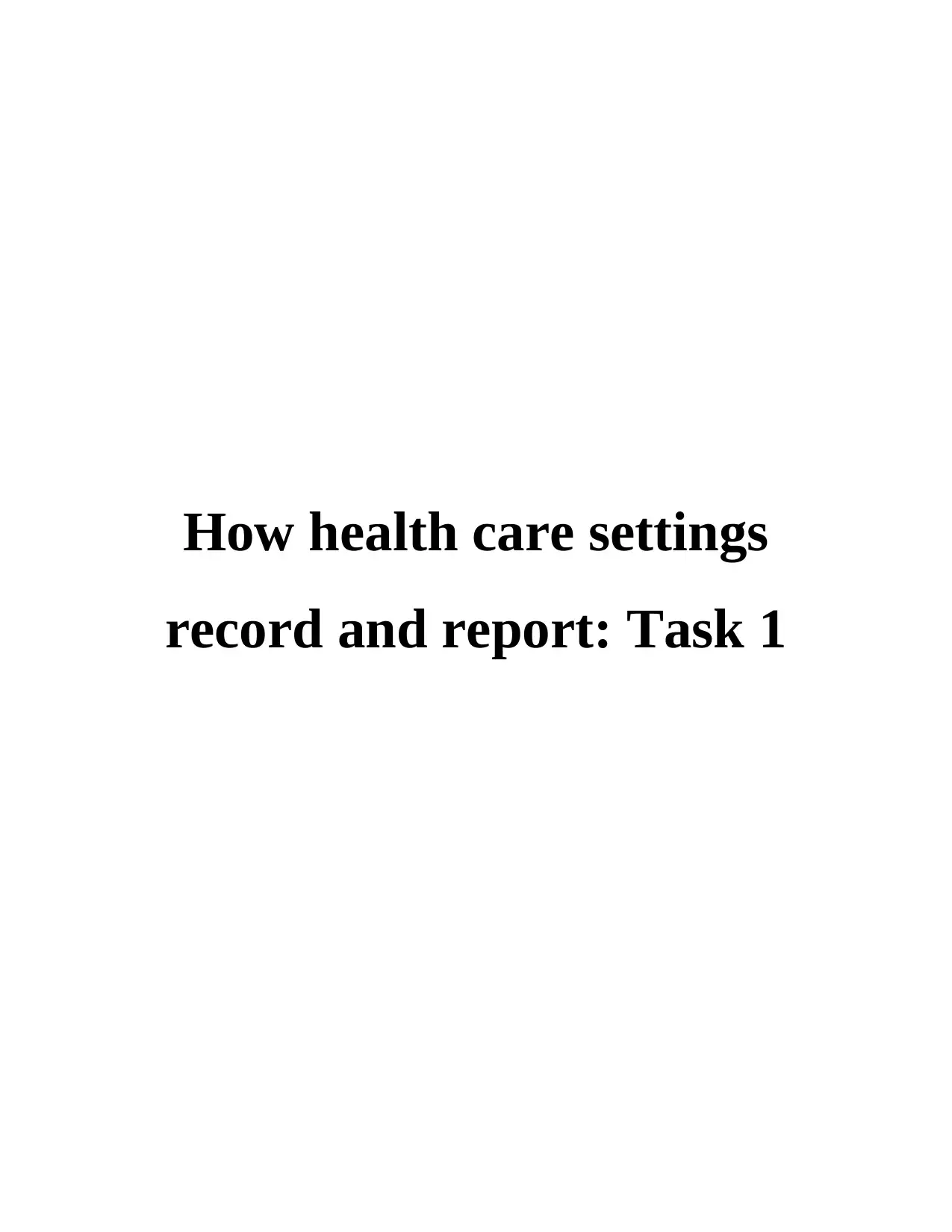
How health care settings
record and report: Task 1
record and report: Task 1
Paraphrase This Document
Need a fresh take? Get an instant paraphrase of this document with our AI Paraphraser
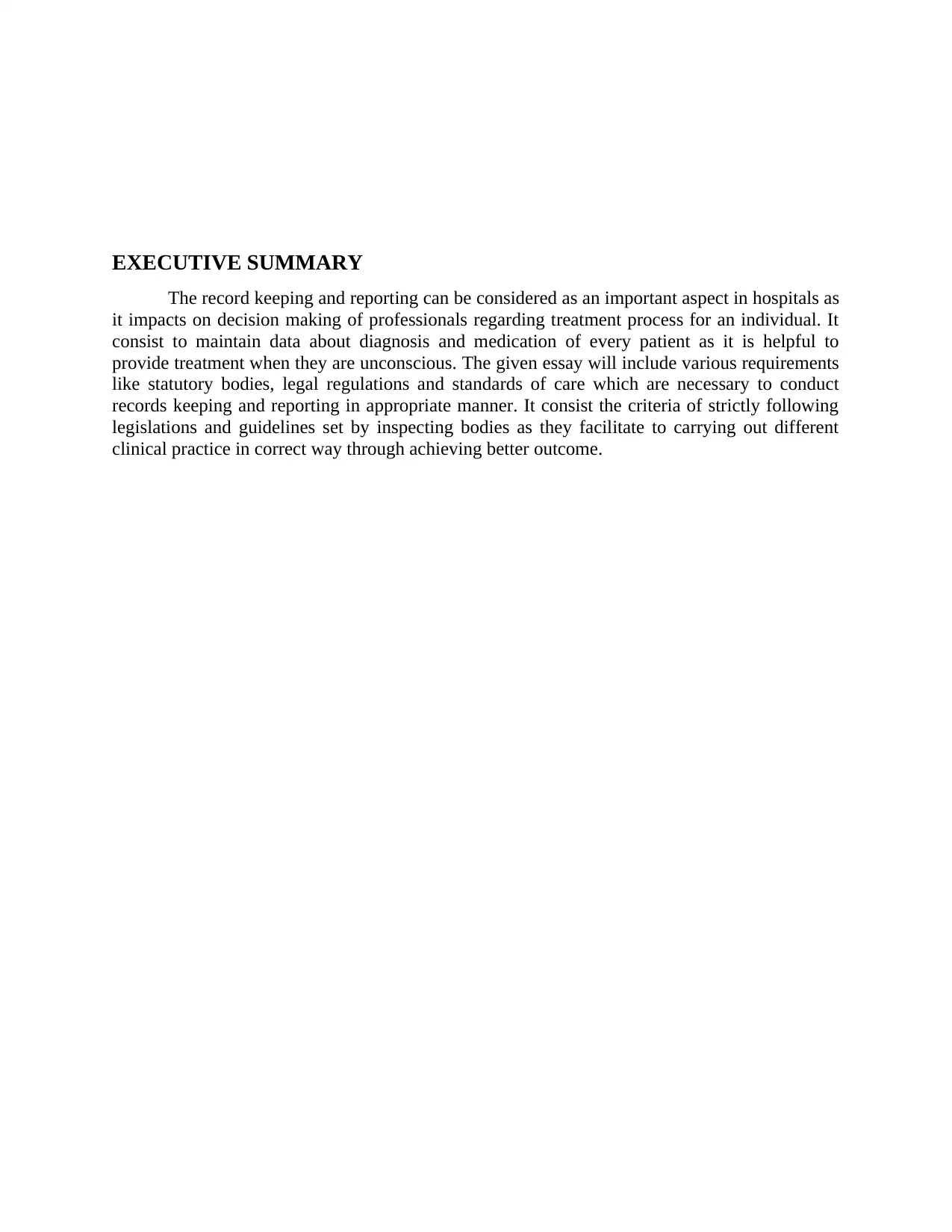
EXECUTIVE SUMMARY
The record keeping and reporting can be considered as an important aspect in hospitals as
it impacts on decision making of professionals regarding treatment process for an individual. It
consist to maintain data about diagnosis and medication of every patient as it is helpful to
provide treatment when they are unconscious. The given essay will include various requirements
like statutory bodies, legal regulations and standards of care which are necessary to conduct
records keeping and reporting in appropriate manner. It consist the criteria of strictly following
legislations and guidelines set by inspecting bodies as they facilitate to carrying out different
clinical practice in correct way through achieving better outcome.
The record keeping and reporting can be considered as an important aspect in hospitals as
it impacts on decision making of professionals regarding treatment process for an individual. It
consist to maintain data about diagnosis and medication of every patient as it is helpful to
provide treatment when they are unconscious. The given essay will include various requirements
like statutory bodies, legal regulations and standards of care which are necessary to conduct
records keeping and reporting in appropriate manner. It consist the criteria of strictly following
legislations and guidelines set by inspecting bodies as they facilitate to carrying out different
clinical practice in correct way through achieving better outcome.
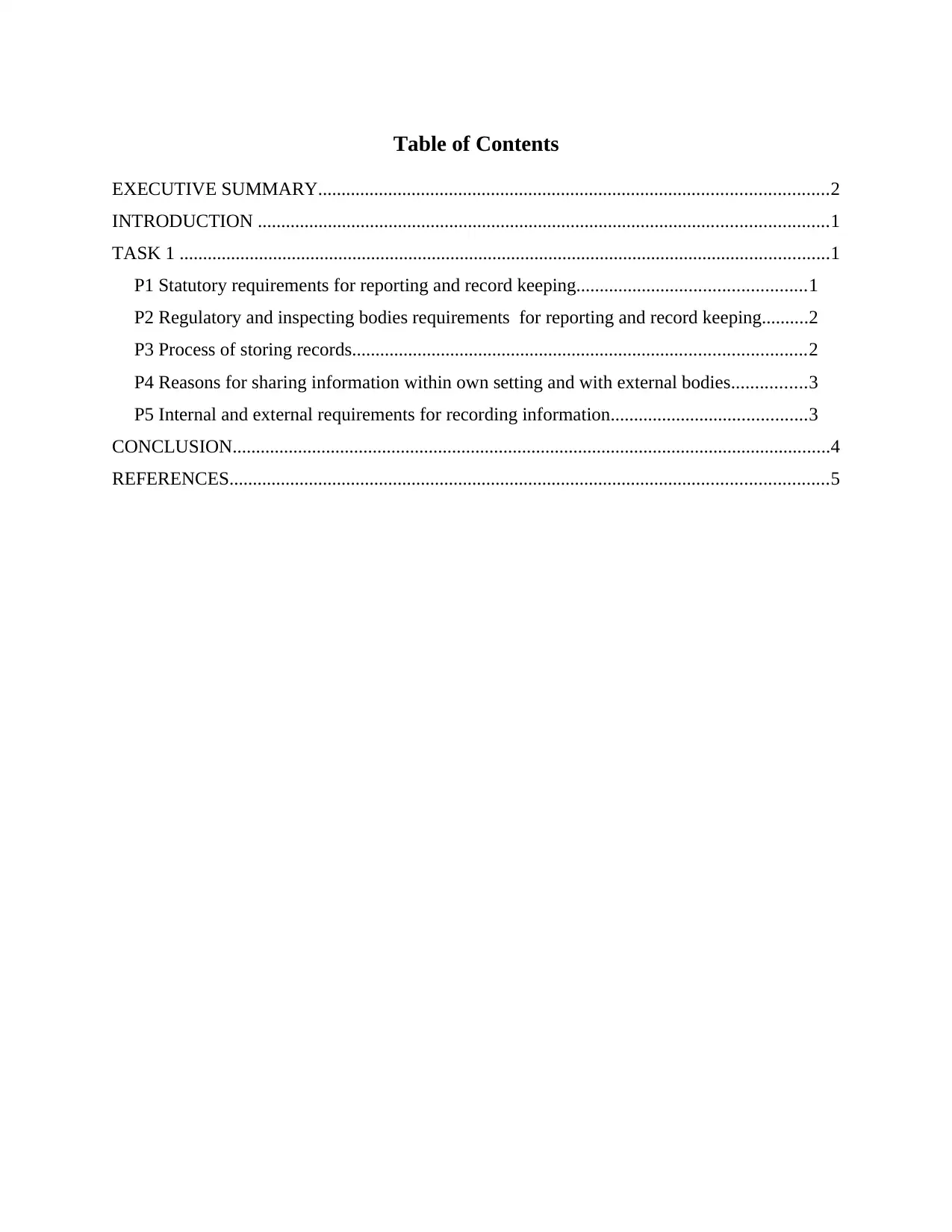
Table of Contents
EXECUTIVE SUMMARY.............................................................................................................2
INTRODUCTION ..........................................................................................................................1
TASK 1 ...........................................................................................................................................1
P1 Statutory requirements for reporting and record keeping.................................................1
P2 Regulatory and inspecting bodies requirements for reporting and record keeping..........2
P3 Process of storing records.................................................................................................2
P4 Reasons for sharing information within own setting and with external bodies................3
P5 Internal and external requirements for recording information..........................................3
CONCLUSION................................................................................................................................4
REFERENCES................................................................................................................................5
EXECUTIVE SUMMARY.............................................................................................................2
INTRODUCTION ..........................................................................................................................1
TASK 1 ...........................................................................................................................................1
P1 Statutory requirements for reporting and record keeping.................................................1
P2 Regulatory and inspecting bodies requirements for reporting and record keeping..........2
P3 Process of storing records.................................................................................................2
P4 Reasons for sharing information within own setting and with external bodies................3
P5 Internal and external requirements for recording information..........................................3
CONCLUSION................................................................................................................................4
REFERENCES................................................................................................................................5
⊘ This is a preview!⊘
Do you want full access?
Subscribe today to unlock all pages.

Trusted by 1+ million students worldwide

Paraphrase This Document
Need a fresh take? Get an instant paraphrase of this document with our AI Paraphraser
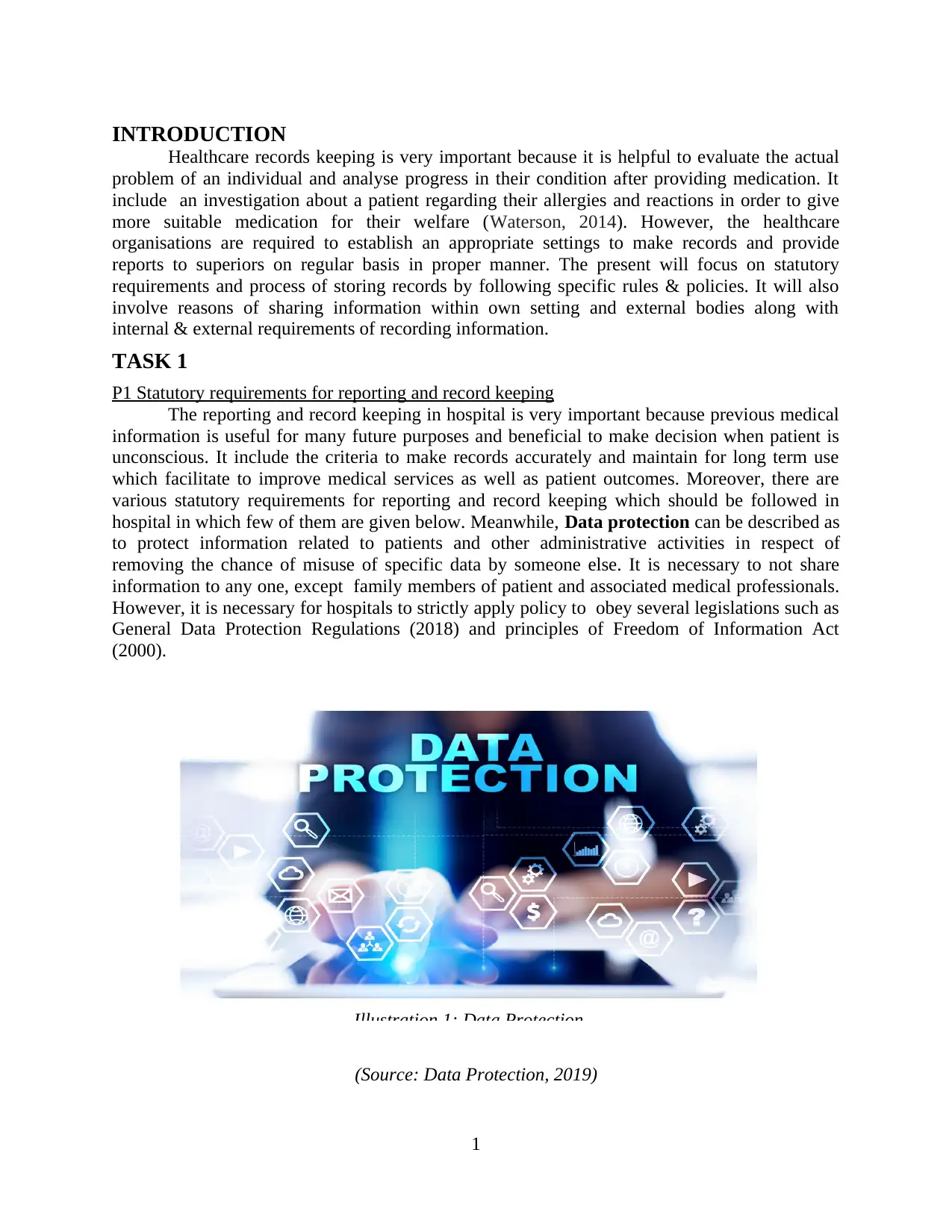
INTRODUCTION
Healthcare records keeping is very important because it is helpful to evaluate the actual
problem of an individual and analyse progress in their condition after providing medication. It
include an investigation about a patient regarding their allergies and reactions in order to give
more suitable medication for their welfare (Waterson, 2014). However, the healthcare
organisations are required to establish an appropriate settings to make records and provide
reports to superiors on regular basis in proper manner. The present will focus on statutory
requirements and process of storing records by following specific rules & policies. It will also
involve reasons of sharing information within own setting and external bodies along with
internal & external requirements of recording information.
TASK 1
P1 Statutory requirements for reporting and record keeping
The reporting and record keeping in hospital is very important because previous medical
information is useful for many future purposes and beneficial to make decision when patient is
unconscious. It include the criteria to make records accurately and maintain for long term use
which facilitate to improve medical services as well as patient outcomes. Moreover, there are
various statutory requirements for reporting and record keeping which should be followed in
hospital in which few of them are given below. Meanwhile, Data protection can be described as
to protect information related to patients and other administrative activities in respect of
removing the chance of misuse of specific data by someone else. It is necessary to not share
information to any one, except family members of patient and associated medical professionals.
However, it is necessary for hospitals to strictly apply policy to obey several legislations such as
General Data Protection Regulations (2018) and principles of Freedom of Information Act
(2000).
(Source: Data Protection, 2019)
1
Illustration 1: Data Protection
Healthcare records keeping is very important because it is helpful to evaluate the actual
problem of an individual and analyse progress in their condition after providing medication. It
include an investigation about a patient regarding their allergies and reactions in order to give
more suitable medication for their welfare (Waterson, 2014). However, the healthcare
organisations are required to establish an appropriate settings to make records and provide
reports to superiors on regular basis in proper manner. The present will focus on statutory
requirements and process of storing records by following specific rules & policies. It will also
involve reasons of sharing information within own setting and external bodies along with
internal & external requirements of recording information.
TASK 1
P1 Statutory requirements for reporting and record keeping
The reporting and record keeping in hospital is very important because previous medical
information is useful for many future purposes and beneficial to make decision when patient is
unconscious. It include the criteria to make records accurately and maintain for long term use
which facilitate to improve medical services as well as patient outcomes. Moreover, there are
various statutory requirements for reporting and record keeping which should be followed in
hospital in which few of them are given below. Meanwhile, Data protection can be described as
to protect information related to patients and other administrative activities in respect of
removing the chance of misuse of specific data by someone else. It is necessary to not share
information to any one, except family members of patient and associated medical professionals.
However, it is necessary for hospitals to strictly apply policy to obey several legislations such as
General Data Protection Regulations (2018) and principles of Freedom of Information Act
(2000).
(Source: Data Protection, 2019)
1
Illustration 1: Data Protection
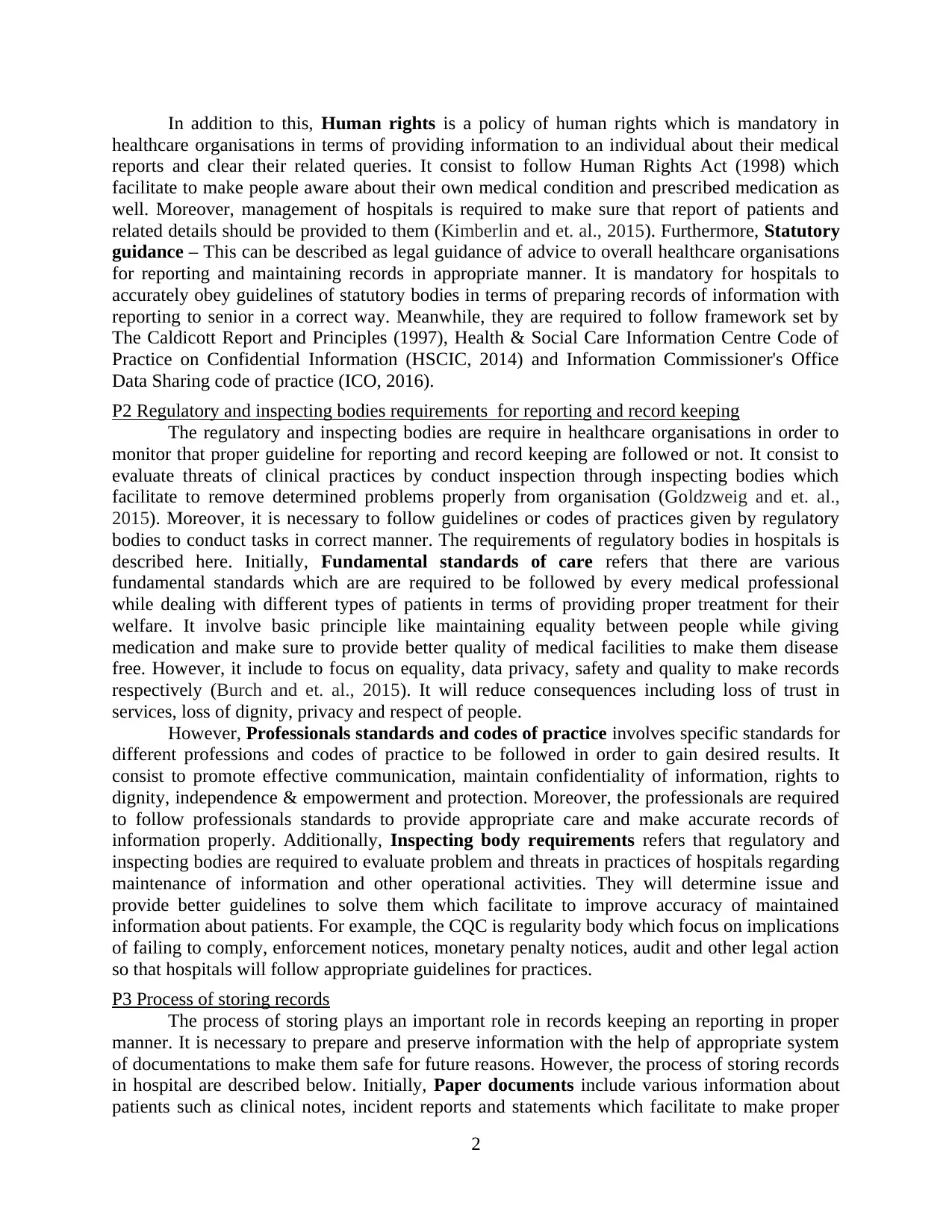
In addition to this, Human rights is a policy of human rights which is mandatory in
healthcare organisations in terms of providing information to an individual about their medical
reports and clear their related queries. It consist to follow Human Rights Act (1998) which
facilitate to make people aware about their own medical condition and prescribed medication as
well. Moreover, management of hospitals is required to make sure that report of patients and
related details should be provided to them (Kimberlin and et. al., 2015). Furthermore, Statutory
guidance – This can be described as legal guidance of advice to overall healthcare organisations
for reporting and maintaining records in appropriate manner. It is mandatory for hospitals to
accurately obey guidelines of statutory bodies in terms of preparing records of information with
reporting to senior in a correct way. Meanwhile, they are required to follow framework set by
The Caldicott Report and Principles (1997), Health & Social Care Information Centre Code of
Practice on Confidential Information (HSCIC, 2014) and Information Commissioner's Office
Data Sharing code of practice (ICO, 2016).
P2 Regulatory and inspecting bodies requirements for reporting and record keeping
The regulatory and inspecting bodies are require in healthcare organisations in order to
monitor that proper guideline for reporting and record keeping are followed or not. It consist to
evaluate threats of clinical practices by conduct inspection through inspecting bodies which
facilitate to remove determined problems properly from organisation (Goldzweig and et. al.,
2015). Moreover, it is necessary to follow guidelines or codes of practices given by regulatory
bodies to conduct tasks in correct manner. The requirements of regulatory bodies in hospitals is
described here. Initially, Fundamental standards of care refers that there are various
fundamental standards which are are required to be followed by every medical professional
while dealing with different types of patients in terms of providing proper treatment for their
welfare. It involve basic principle like maintaining equality between people while giving
medication and make sure to provide better quality of medical facilities to make them disease
free. However, it include to focus on equality, data privacy, safety and quality to make records
respectively (Burch and et. al., 2015). It will reduce consequences including loss of trust in
services, loss of dignity, privacy and respect of people.
However, Professionals standards and codes of practice involves specific standards for
different professions and codes of practice to be followed in order to gain desired results. It
consist to promote effective communication, maintain confidentiality of information, rights to
dignity, independence & empowerment and protection. Moreover, the professionals are required
to follow professionals standards to provide appropriate care and make accurate records of
information properly. Additionally, Inspecting body requirements refers that regulatory and
inspecting bodies are required to evaluate problem and threats in practices of hospitals regarding
maintenance of information and other operational activities. They will determine issue and
provide better guidelines to solve them which facilitate to improve accuracy of maintained
information about patients. For example, the CQC is regularity body which focus on implications
of failing to comply, enforcement notices, monetary penalty notices, audit and other legal action
so that hospitals will follow appropriate guidelines for practices.
P3 Process of storing records
The process of storing plays an important role in records keeping an reporting in proper
manner. It is necessary to prepare and preserve information with the help of appropriate system
of documentations to make them safe for future reasons. However, the process of storing records
in hospital are described below. Initially, Paper documents include various information about
patients such as clinical notes, incident reports and statements which facilitate to make proper
2
healthcare organisations in terms of providing information to an individual about their medical
reports and clear their related queries. It consist to follow Human Rights Act (1998) which
facilitate to make people aware about their own medical condition and prescribed medication as
well. Moreover, management of hospitals is required to make sure that report of patients and
related details should be provided to them (Kimberlin and et. al., 2015). Furthermore, Statutory
guidance – This can be described as legal guidance of advice to overall healthcare organisations
for reporting and maintaining records in appropriate manner. It is mandatory for hospitals to
accurately obey guidelines of statutory bodies in terms of preparing records of information with
reporting to senior in a correct way. Meanwhile, they are required to follow framework set by
The Caldicott Report and Principles (1997), Health & Social Care Information Centre Code of
Practice on Confidential Information (HSCIC, 2014) and Information Commissioner's Office
Data Sharing code of practice (ICO, 2016).
P2 Regulatory and inspecting bodies requirements for reporting and record keeping
The regulatory and inspecting bodies are require in healthcare organisations in order to
monitor that proper guideline for reporting and record keeping are followed or not. It consist to
evaluate threats of clinical practices by conduct inspection through inspecting bodies which
facilitate to remove determined problems properly from organisation (Goldzweig and et. al.,
2015). Moreover, it is necessary to follow guidelines or codes of practices given by regulatory
bodies to conduct tasks in correct manner. The requirements of regulatory bodies in hospitals is
described here. Initially, Fundamental standards of care refers that there are various
fundamental standards which are are required to be followed by every medical professional
while dealing with different types of patients in terms of providing proper treatment for their
welfare. It involve basic principle like maintaining equality between people while giving
medication and make sure to provide better quality of medical facilities to make them disease
free. However, it include to focus on equality, data privacy, safety and quality to make records
respectively (Burch and et. al., 2015). It will reduce consequences including loss of trust in
services, loss of dignity, privacy and respect of people.
However, Professionals standards and codes of practice involves specific standards for
different professions and codes of practice to be followed in order to gain desired results. It
consist to promote effective communication, maintain confidentiality of information, rights to
dignity, independence & empowerment and protection. Moreover, the professionals are required
to follow professionals standards to provide appropriate care and make accurate records of
information properly. Additionally, Inspecting body requirements refers that regulatory and
inspecting bodies are required to evaluate problem and threats in practices of hospitals regarding
maintenance of information and other operational activities. They will determine issue and
provide better guidelines to solve them which facilitate to improve accuracy of maintained
information about patients. For example, the CQC is regularity body which focus on implications
of failing to comply, enforcement notices, monetary penalty notices, audit and other legal action
so that hospitals will follow appropriate guidelines for practices.
P3 Process of storing records
The process of storing plays an important role in records keeping an reporting in proper
manner. It is necessary to prepare and preserve information with the help of appropriate system
of documentations to make them safe for future reasons. However, the process of storing records
in hospital are described below. Initially, Paper documents include various information about
patients such as clinical notes, incident reports and statements which facilitate to make proper
2
⊘ This is a preview!⊘
Do you want full access?
Subscribe today to unlock all pages.

Trusted by 1+ million students worldwide
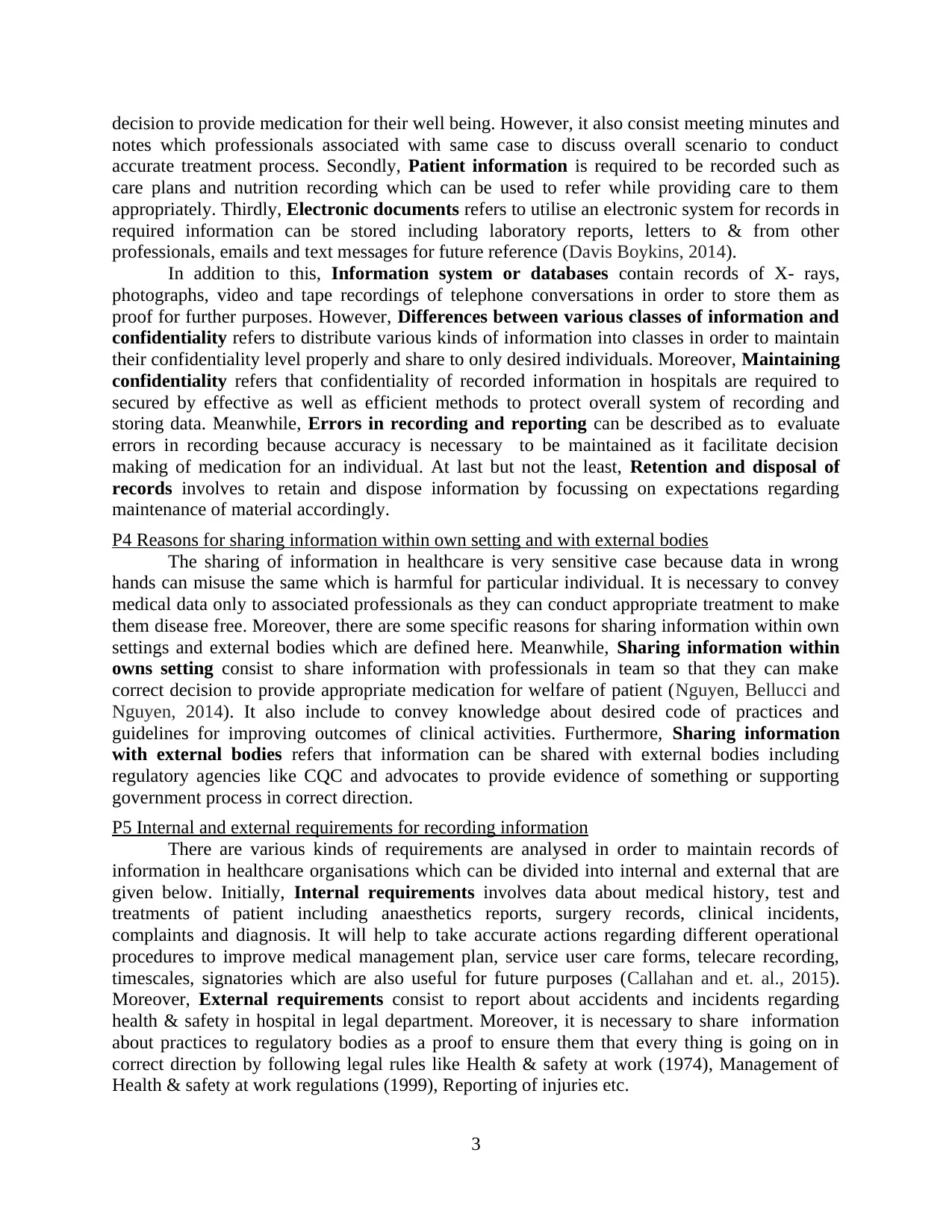
decision to provide medication for their well being. However, it also consist meeting minutes and
notes which professionals associated with same case to discuss overall scenario to conduct
accurate treatment process. Secondly, Patient information is required to be recorded such as
care plans and nutrition recording which can be used to refer while providing care to them
appropriately. Thirdly, Electronic documents refers to utilise an electronic system for records in
required information can be stored including laboratory reports, letters to & from other
professionals, emails and text messages for future reference (Davis Boykins, 2014).
In addition to this, Information system or databases contain records of X- rays,
photographs, video and tape recordings of telephone conversations in order to store them as
proof for further purposes. However, Differences between various classes of information and
confidentiality refers to distribute various kinds of information into classes in order to maintain
their confidentiality level properly and share to only desired individuals. Moreover, Maintaining
confidentiality refers that confidentiality of recorded information in hospitals are required to
secured by effective as well as efficient methods to protect overall system of recording and
storing data. Meanwhile, Errors in recording and reporting can be described as to evaluate
errors in recording because accuracy is necessary to be maintained as it facilitate decision
making of medication for an individual. At last but not the least, Retention and disposal of
records involves to retain and dispose information by focussing on expectations regarding
maintenance of material accordingly.
P4 Reasons for sharing information within own setting and with external bodies
The sharing of information in healthcare is very sensitive case because data in wrong
hands can misuse the same which is harmful for particular individual. It is necessary to convey
medical data only to associated professionals as they can conduct appropriate treatment to make
them disease free. Moreover, there are some specific reasons for sharing information within own
settings and external bodies which are defined here. Meanwhile, Sharing information within
owns setting consist to share information with professionals in team so that they can make
correct decision to provide appropriate medication for welfare of patient (Nguyen, Bellucci and
Nguyen, 2014). It also include to convey knowledge about desired code of practices and
guidelines for improving outcomes of clinical activities. Furthermore, Sharing information
with external bodies refers that information can be shared with external bodies including
regulatory agencies like CQC and advocates to provide evidence of something or supporting
government process in correct direction.
P5 Internal and external requirements for recording information
There are various kinds of requirements are analysed in order to maintain records of
information in healthcare organisations which can be divided into internal and external that are
given below. Initially, Internal requirements involves data about medical history, test and
treatments of patient including anaesthetics reports, surgery records, clinical incidents,
complaints and diagnosis. It will help to take accurate actions regarding different operational
procedures to improve medical management plan, service user care forms, telecare recording,
timescales, signatories which are also useful for future purposes (Callahan and et. al., 2015).
Moreover, External requirements consist to report about accidents and incidents regarding
health & safety in hospital in legal department. Moreover, it is necessary to share information
about practices to regulatory bodies as a proof to ensure them that every thing is going on in
correct direction by following legal rules like Health & safety at work (1974), Management of
Health & safety at work regulations (1999), Reporting of injuries etc.
3
notes which professionals associated with same case to discuss overall scenario to conduct
accurate treatment process. Secondly, Patient information is required to be recorded such as
care plans and nutrition recording which can be used to refer while providing care to them
appropriately. Thirdly, Electronic documents refers to utilise an electronic system for records in
required information can be stored including laboratory reports, letters to & from other
professionals, emails and text messages for future reference (Davis Boykins, 2014).
In addition to this, Information system or databases contain records of X- rays,
photographs, video and tape recordings of telephone conversations in order to store them as
proof for further purposes. However, Differences between various classes of information and
confidentiality refers to distribute various kinds of information into classes in order to maintain
their confidentiality level properly and share to only desired individuals. Moreover, Maintaining
confidentiality refers that confidentiality of recorded information in hospitals are required to
secured by effective as well as efficient methods to protect overall system of recording and
storing data. Meanwhile, Errors in recording and reporting can be described as to evaluate
errors in recording because accuracy is necessary to be maintained as it facilitate decision
making of medication for an individual. At last but not the least, Retention and disposal of
records involves to retain and dispose information by focussing on expectations regarding
maintenance of material accordingly.
P4 Reasons for sharing information within own setting and with external bodies
The sharing of information in healthcare is very sensitive case because data in wrong
hands can misuse the same which is harmful for particular individual. It is necessary to convey
medical data only to associated professionals as they can conduct appropriate treatment to make
them disease free. Moreover, there are some specific reasons for sharing information within own
settings and external bodies which are defined here. Meanwhile, Sharing information within
owns setting consist to share information with professionals in team so that they can make
correct decision to provide appropriate medication for welfare of patient (Nguyen, Bellucci and
Nguyen, 2014). It also include to convey knowledge about desired code of practices and
guidelines for improving outcomes of clinical activities. Furthermore, Sharing information
with external bodies refers that information can be shared with external bodies including
regulatory agencies like CQC and advocates to provide evidence of something or supporting
government process in correct direction.
P5 Internal and external requirements for recording information
There are various kinds of requirements are analysed in order to maintain records of
information in healthcare organisations which can be divided into internal and external that are
given below. Initially, Internal requirements involves data about medical history, test and
treatments of patient including anaesthetics reports, surgery records, clinical incidents,
complaints and diagnosis. It will help to take accurate actions regarding different operational
procedures to improve medical management plan, service user care forms, telecare recording,
timescales, signatories which are also useful for future purposes (Callahan and et. al., 2015).
Moreover, External requirements consist to report about accidents and incidents regarding
health & safety in hospital in legal department. Moreover, it is necessary to share information
about practices to regulatory bodies as a proof to ensure them that every thing is going on in
correct direction by following legal rules like Health & safety at work (1974), Management of
Health & safety at work regulations (1999), Reporting of injuries etc.
3
Paraphrase This Document
Need a fresh take? Get an instant paraphrase of this document with our AI Paraphraser
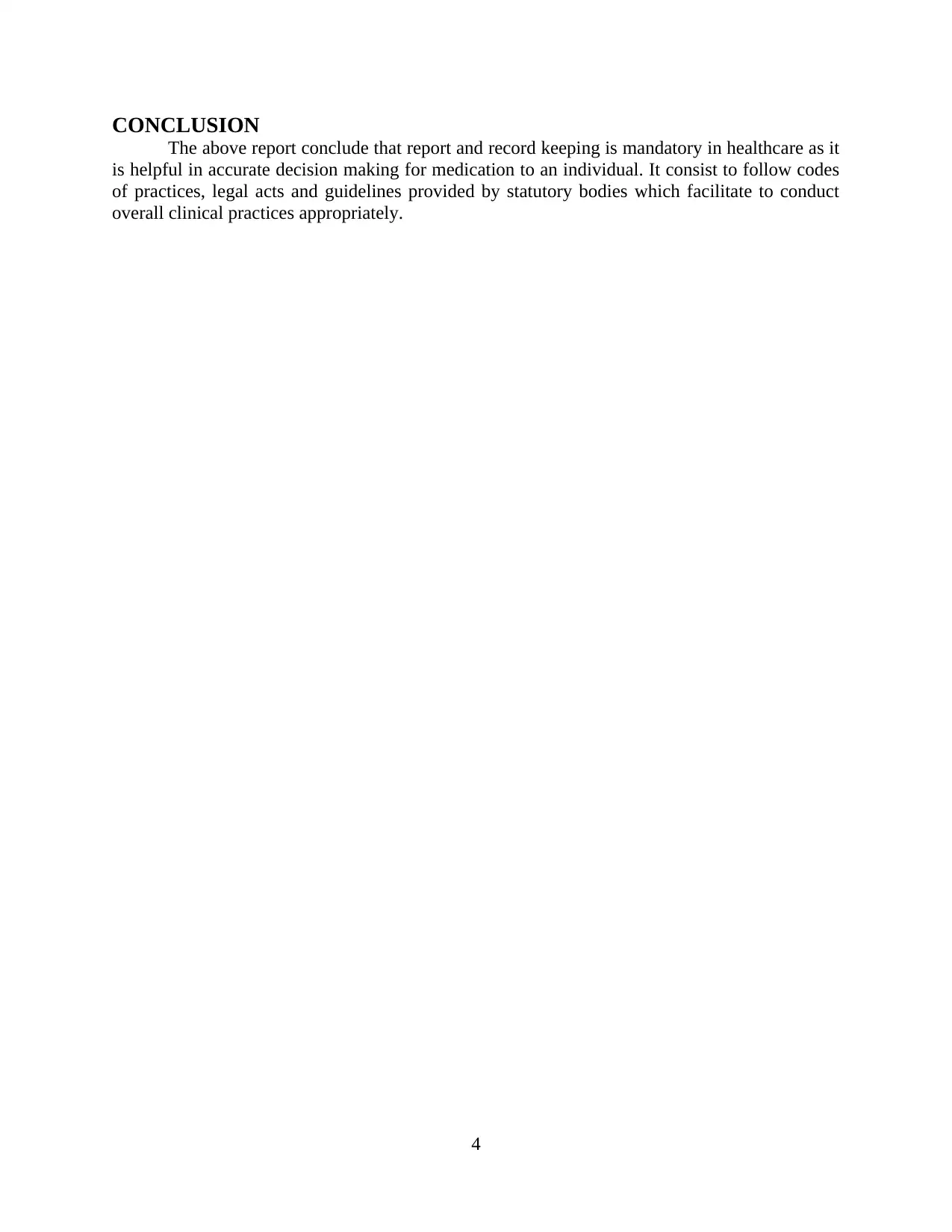
CONCLUSION
The above report conclude that report and record keeping is mandatory in healthcare as it
is helpful in accurate decision making for medication to an individual. It consist to follow codes
of practices, legal acts and guidelines provided by statutory bodies which facilitate to conduct
overall clinical practices appropriately.
4
The above report conclude that report and record keeping is mandatory in healthcare as it
is helpful in accurate decision making for medication to an individual. It consist to follow codes
of practices, legal acts and guidelines provided by statutory bodies which facilitate to conduct
overall clinical practices appropriately.
4
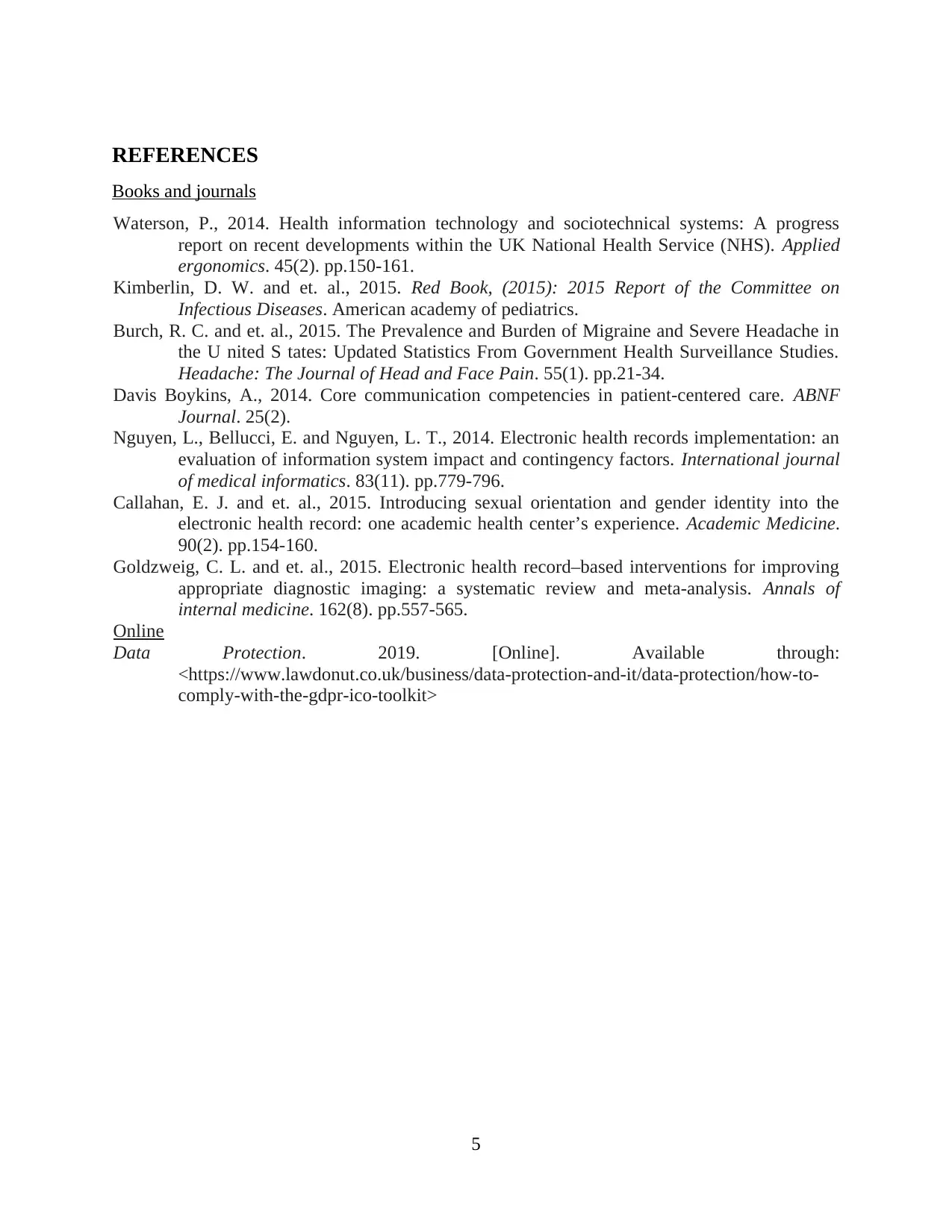
REFERENCES
Books and journals
Waterson, P., 2014. Health information technology and sociotechnical systems: A progress
report on recent developments within the UK National Health Service (NHS). Applied
ergonomics. 45(2). pp.150-161.
Kimberlin, D. W. and et. al., 2015. Red Book, (2015): 2015 Report of the Committee on
Infectious Diseases. American academy of pediatrics.
Burch, R. C. and et. al., 2015. The Prevalence and Burden of Migraine and Severe Headache in
the U nited S tates: Updated Statistics From Government Health Surveillance Studies.
Headache: The Journal of Head and Face Pain. 55(1). pp.21-34.
Davis Boykins, A., 2014. Core communication competencies in patient-centered care. ABNF
Journal. 25(2).
Nguyen, L., Bellucci, E. and Nguyen, L. T., 2014. Electronic health records implementation: an
evaluation of information system impact and contingency factors. International journal
of medical informatics. 83(11). pp.779-796.
Callahan, E. J. and et. al., 2015. Introducing sexual orientation and gender identity into the
electronic health record: one academic health center’s experience. Academic Medicine.
90(2). pp.154-160.
Goldzweig, C. L. and et. al., 2015. Electronic health record–based interventions for improving
appropriate diagnostic imaging: a systematic review and meta-analysis. Annals of
internal medicine. 162(8). pp.557-565.
Online
Data Protection. 2019. [Online]. Available through:
<https://www.lawdonut.co.uk/business/data-protection-and-it/data-protection/how-to-
comply-with-the-gdpr-ico-toolkit>
5
Books and journals
Waterson, P., 2014. Health information technology and sociotechnical systems: A progress
report on recent developments within the UK National Health Service (NHS). Applied
ergonomics. 45(2). pp.150-161.
Kimberlin, D. W. and et. al., 2015. Red Book, (2015): 2015 Report of the Committee on
Infectious Diseases. American academy of pediatrics.
Burch, R. C. and et. al., 2015. The Prevalence and Burden of Migraine and Severe Headache in
the U nited S tates: Updated Statistics From Government Health Surveillance Studies.
Headache: The Journal of Head and Face Pain. 55(1). pp.21-34.
Davis Boykins, A., 2014. Core communication competencies in patient-centered care. ABNF
Journal. 25(2).
Nguyen, L., Bellucci, E. and Nguyen, L. T., 2014. Electronic health records implementation: an
evaluation of information system impact and contingency factors. International journal
of medical informatics. 83(11). pp.779-796.
Callahan, E. J. and et. al., 2015. Introducing sexual orientation and gender identity into the
electronic health record: one academic health center’s experience. Academic Medicine.
90(2). pp.154-160.
Goldzweig, C. L. and et. al., 2015. Electronic health record–based interventions for improving
appropriate diagnostic imaging: a systematic review and meta-analysis. Annals of
internal medicine. 162(8). pp.557-565.
Online
Data Protection. 2019. [Online]. Available through:
<https://www.lawdonut.co.uk/business/data-protection-and-it/data-protection/how-to-
comply-with-the-gdpr-ico-toolkit>
5
⊘ This is a preview!⊘
Do you want full access?
Subscribe today to unlock all pages.

Trusted by 1+ million students worldwide
1 out of 9
Related Documents
Your All-in-One AI-Powered Toolkit for Academic Success.
+13062052269
info@desklib.com
Available 24*7 on WhatsApp / Email
![[object Object]](/_next/static/media/star-bottom.7253800d.svg)
Unlock your academic potential
Copyright © 2020–2025 A2Z Services. All Rights Reserved. Developed and managed by ZUCOL.





